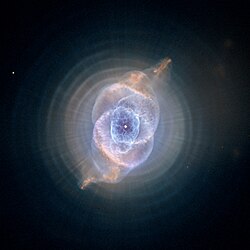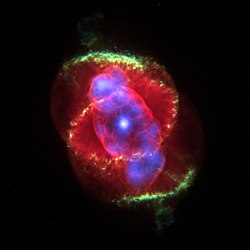Heic0414b
Autor/Urheber:
Nordic Optical Telescope and Romano Corradi (Isaac Newton Group of Telescopes, Spain)
Shortlink:
Quelle:
Größe:
2048 x 2048 Pixel (809175 Bytes)
Beschreibung:
An enormous but extremely faint halo of gaseous material surrounds the Cat's Eye Nebula and is over three light-years across. Within the past years some planetary nebulae been found to have halos like this one, likely formed of material ejected during earlier active episodes in the star's evolution - most likely some 50,000 to 90,000 years ago.
This image was taken by Romano Corradi with the Nordic Optical Telescope on La Palma in the Canary Islands. The image is constructed from two narrow-band exposures showing oxygen atoms (1800 seconds, in blue) and nitrogen atoms (1800 seconds, in red).
Kommentar zur Lizenz:
| This file is in the public domain because it was created by NASA and ESA. NASA Hubble material (and ESA Hubble material prior to 2009) is copyright-free and may be freely used as in the public domain without fee, on the condition that only NASA, STScI, and/or ESA is credited as the source of the material. This license does not apply if ESA material created after 2008 or source material from other organizations is in use. The material was created for NASA by Space Telescope Science Institute under Contract NAS5-26555, or for ESA by the Hubble European Space Agency Information Centre. Copyright statement at hubblesite.org or 2008 copyright statement at spacetelescope.org. For material created by the European Space Agency on the spacetelescope.org site since 2009, use the {{ESA-Hubble}} tag. |
Lizenz:
Public domain
Relevante Bilder
Relevante Artikel
KatzenaugennebelDer Katzenaugennebel ist ein Planetarischer Nebel im Sternbild Drache am Nordsternhimmel. Er ist strukturell einer der komplexesten unter den bekannten Nebeln. Hochauflösende Aufnahmen des Hubble-Weltraumteleskops enthüllten außergewöhnliche Strukturen wie Knoten, Jets und bogenartige Merkmale. Visuell ähnelt er dem Katzenauge und wurde entsprechend benannt. .. weiterlesen




